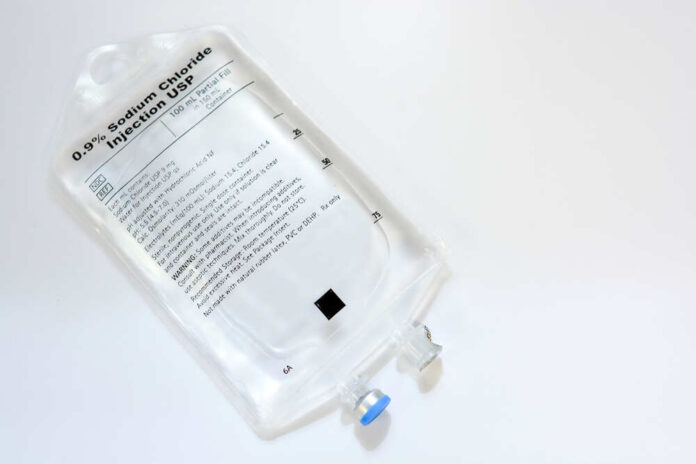
Hurricane Helene’s aftermath forces hospitals to get creative with patient care as IV fluid shortage looms.
In the wake of Hurricane Helene, hospitals across the nation are grappling with a severe shortage of intravenous (IV) fluids, forcing healthcare professionals to adopt innovative approaches to patient care. The shortage, caused by flooding at a crucial manufacturing facility in North Carolina, has led to a widespread scramble for alternative hydration methods and medication delivery systems. As healthcare providers adapt to this unexpected challenge, patients are being encouraged to consume oral fluids like Gatorade, while hospitals implement stringent conservation measures to stretch their dwindling IV fluid supplies.
The Perfect Storm: Hurricane Helene and the IV Fluid Crisis
Hurricane Helene’s destructive path through North Carolina did more than just ravage coastal communities – it struck a critical blow to the nation’s healthcare supply chain. The storm’s floodwaters inundated a Baxter-operated factory, a key producer of IV fluid bags, triggering a domino effect that’s now being felt in hospitals across the country. While the plant has partially reopened, it won’t be shipping IV bags until late November, leaving medical facilities in a precarious position. This unforeseen disaster has exposed a glaring vulnerability in our healthcare infrastructure, begging the question: why are we so dependent on a single source for such a vital medical resource?
The shortage has forced hospitals to slash IV fluid use by as much as 55%, a drastic measure that underscores the severity of the situation. Healthcare providers are now walking a tightrope, balancing patient needs with dwindling supplies. It’s a stark reminder of how natural disasters can have far-reaching consequences beyond their immediate impact zone, disrupting critical supply chains and challenging our ability to provide essential medical care.
Necessity Breeds Innovation: Hospitals Get Creative
In the face of this crisis, hospitals are proving that necessity truly is the mother of invention. Medical teams are pivoting to alternative methods of hydration and medication delivery, showcasing the resilience and adaptability of our healthcare system. Patients are being transitioned from IV antibiotics to oral pills sooner, a move that not only conserves precious IV fluids but also potentially reduces hospital stays. Some facilities are exploring more direct methods of medication administration, “pushing” drugs without the use of IV bags.
“We’re kind of limited to water bottles. We can’t give our patients ice chips, like many of them request.” – Bunting
The FDA approved the import of certain IV fluids from overseas. Hospitals have been struggling with an IV fluid shortage after Hurricane Helene.#IVFluids #HurricaneHelenehttps://t.co/HNHqT5AtJG?
— Healthcare Innovation (@HCInnovationGrp) October 11, 2024
This quote from Bunting paints a vivid picture of the day-to-day challenges hospitals are facing. It’s a stark reminder that even the simplest comforts we take for granted in medical care can be disrupted by unforeseen events. But let’s be real here – if the biggest complaint is a lack of ice chips, maybe we’re not doing so bad after all. Still, it’s a wake-up call that our healthcare system needs to be more resilient and less dependent on single sources for critical supplies.
The Silver Lining: Reassessing Medical Practices
Believe it or not, some hospitals are viewing this shortage as an opportunity to reassess and potentially reduce unnecessary IV fluid use. It’s about damn time! How many times have we seen the healthcare system mindlessly following protocols without questioning their necessity or efficiency? This crisis is forcing a hard look at standard practices, which might just lead to more efficient and cost-effective care in the long run. Who knew it would take a hurricane to make us realize we might be overusing IV fluids?
“Maybe getting 60% of our IV fluids from one single source isn’t the smartest long-term plan.” – Bunting
Well, no shit, Sherlock! It’s mind-boggling that it took a crisis of this magnitude for healthcare administrators to realize the folly of relying so heavily on a single source for such a critical resource. This is the kind of short-sighted planning that drives conservatives up the wall. It’s a textbook example of why we need more diverse, resilient supply chains in all critical sectors, not just healthcare. Let’s hope this serves as a wake-up call for other industries as well.
The Road Ahead: Challenges and Concerns
While hospitals are admirably adapting to the current situation, serious concerns linger about the long-term impact on patient outcomes. With some facilities down to a mere two-week supply of IV fluids, the approaching respiratory virus season looms like a dark cloud on the horizon. It’s a ticking time bomb that could push our already strained healthcare system to the breaking point. This is what happens when we put all our eggs in one basket, folks. It’s high time we started thinking about decentralizing our medical supply chains and building in some redundancy.
“I think the workaround right now is working really well. I don’t know what it’s going to look like next week or next month.” – Bridges
This quote from Bridges perfectly encapsulates the uncertainty hanging over our healthcare system right now. It’s great that they’ve found workarounds, but living week-to-week is no way to run a hospital. This kind of short-term thinking is exactly what got us into this mess in the first place. We need long-term solutions and a complete overhaul of how we approach medical supply chains. Otherwise, we’re just waiting for the next disaster to throw us into chaos again. Wake up, America! It’s time to demand better from our healthcare system and our leaders.














